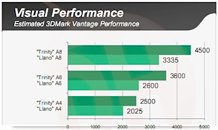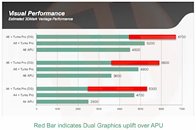- Joined
- Oct 9, 2007
- Messages
- 47,297 (7.53/day)
- Location
- Hyderabad, India
| System Name | RBMK-1000 |
|---|---|
| Processor | AMD Ryzen 7 5700G |
| Motherboard | ASUS ROG Strix B450-E Gaming |
| Cooling | DeepCool Gammax L240 V2 |
| Memory | 2x 8GB G.Skill Sniper X |
| Video Card(s) | Palit GeForce RTX 2080 SUPER GameRock |
| Storage | Western Digital Black NVMe 512GB |
| Display(s) | BenQ 1440p 60 Hz 27-inch |
| Case | Corsair Carbide 100R |
| Audio Device(s) | ASUS SupremeFX S1220A |
| Power Supply | Cooler Master MWE Gold 650W |
| Mouse | ASUS ROG Strix Impact |
| Keyboard | Gamdias Hermes E2 |
| Software | Windows 11 Pro |
"Trinity" is the codename of AMD's next-generation performance accelerated processing unit (APU) family. Based on the new socket FM2 package, these chips will take advantage of AMD's next-generation Piledriver processor core architecture and VLIW4 GPU stream processor architecture. Together, Trinity promises increased general, visual, and parallel compute performance. Some of the slides detailing AMD's own performance estimates were put up by DonanimHaber in their recent video bulletin. We screen-grabbed the performance graphs from the low-resolution video, hence the grainy images.
To begin with, AMD is promising noticeable performance improvements over the current "Llano" APU. It spread its benchmarks across three categories: visual performance (using 3DMark Vantage), general performance (using PCMark Vantage), and parallel compute (GPGPU) performance (calculated CTP SP GFLOPs). With 3DMark Vantage, Trinity A8 (quad-core), A6 (triple-core), and A4 (dual-core) APUs are seeing a roughly 32% improvement over their respective Llano-based counterparts; with general performance, the improvement is a candid 13.8% on average; but with GPGPU performance, the improvement is a massive 56.3% on average. This could be attributed to the VLIW4 architecture. Lastly, there are notable CrossFire dual-graphics performance improvements.




View at TechPowerUp Main Site
To begin with, AMD is promising noticeable performance improvements over the current "Llano" APU. It spread its benchmarks across three categories: visual performance (using 3DMark Vantage), general performance (using PCMark Vantage), and parallel compute (GPGPU) performance (calculated CTP SP GFLOPs). With 3DMark Vantage, Trinity A8 (quad-core), A6 (triple-core), and A4 (dual-core) APUs are seeing a roughly 32% improvement over their respective Llano-based counterparts; with general performance, the improvement is a candid 13.8% on average; but with GPGPU performance, the improvement is a massive 56.3% on average. This could be attributed to the VLIW4 architecture. Lastly, there are notable CrossFire dual-graphics performance improvements.




View at TechPowerUp Main Site




 , but that might be awhile
, but that might be awhile 
